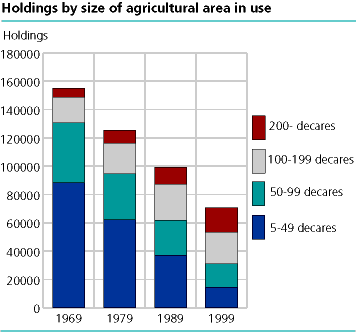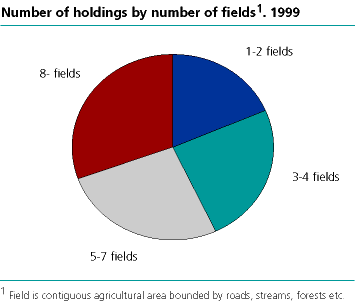Content
Published:
Great structural changes in agriculture
Half as many farms, twice as big holdings, 70-80 per cent fewer holdings with livestock and increased size of livestock. These are the changes in Norwegian agriculture from 1969 to 1999.
In 1999 there were 70 740 holdings with agricultural area in use. This represents a fall of 55 per cent since 1969. The average holding operated 147 decares in 1999. While four out of five holdings operated less than 100 decares in 1969, two out of five operated an area of this size in 1999. The number of holdings with 300 decares or more was almost tripled.
The agricultural area increased in the period by about 8 per cent to 10.3 million decares. Land rental increased strongly, and in 1999 almost a third of all agricultural land was rented. In 1979 about a fifth of the area was rented.
Increased animal livestocks
As for agricultural land, the animal livestock has become concentrated at less and bigger holdings. With the exceptionof dairy cows, the number of animals has increased for most other sorts. The increase was biggest for pigs for breeding, which increased by almost 30 per cent the last 30 years. The number of holdings with livestock fell dramatically, and the decrease was between 70 and 80 per cent.
79 500 full time equivalents
The labour input in agriculture and horticulture corresponded to 79 500 full time equivalents in 1998/1999. 77 per cent of the labour input was conducted by the holders themselves, while family members, regularly and temporarily employees conducted the rest. At half of the holdings, the labour input corresponded to one full time equivalents or more, while one out of three holdings had labour input corresponding to less than half a full time equivalent each. On average it was conducted 1.1 full time equivalents per holding.
36 000 holders, included spouse and cohabitants, worked 1 500 hours or more at the holding. This represented less than 30 per cent of all holders. In 1989 more than 20 per cent of the holders worked 1 500 hours or more at the holding.
For the first time, labour input in supplemental industries has been surveyed. Supplemental industries are activities that utilise a holdings land, buildings or machinery. At 29 000 holdings there was conducted 4 400 full time equivalents in these industries. Machinery-related services were the largest supplemental industry, in which just about 14 000 holdings were engaged in 1998/1999.
Younger holders
The average age fell from 54 years in 1969 to 48 years in 1999. The part of holders younger than 50 years increased from 36 per cent in 1969 to 55 per cent in 1999. The part of holders 60 years and older decreased, and represented 17 per cent of all holders in 1999.
Many small fields
For the first time questions about fields and parcels has been surveyed. The average size of parcels and fields was in 1999 respectively 47 decares and 23 decares, but there were big differences between the counties. A parcel means agricultural land completely surrounded by land belonging to other properties. A field is a contiguous agricultural area bounded by roads, streams, forests etc. A parcel consists of one or more fields. In Eastern Norway the parcels were biggest, while the smallest were in the counties of Agder. The size of the parcels and the fields is one out of several factors that determine how effective the area can be operated. Usually it is more time-consuming to operate a split up area compared with one big area or field. On the other hand, from an environmental point of view it is more desirable with an agricultural landscape consisting of more split-up and heterogeneous areas.
More results
This article is for the moment the last article that comments final results from the 1999 agricultural census. Since December 2000 the results have been presented in a series of articles about each county. By clicking at "Previous articles" to the left, all the articles with attached tables will appear. Detailed figures for the municipalities are presented in the attached tables, and in the Norwegian pages "Fakta om kommunene". By contacting Statistics Norway, it is possible to get more results, or to group the results in other ways.
In May/June paper-publications with figures at country-, county- and at municipality level will be published.
Tables:
- Table 1 Number of holdings, by size of agricultural area in use and county. 1969, 1979, 1989 and 1999
- Table 2 Agricultural area in use, by use and county. 1969, 1979, 1989 and 1999. Decares
- Table 3 Number of holdings with different crops, by county. 1969, 1979, 1989 and 1999
- Table 4 Holdings with cultivated meadow for mowing and pasturing and area of cultivated meadow for mowing and pasturing by age of the meadow, by county. 1999
- Table 5 Holdings which rent land, and size of rented area, by county. 1979, 1989 and 1999
- Table 6 Holdings, by number of parcels, fields and county. 1999
- Table 7 Number of animals, by county. 1969, 1979, 1989 and 1999
- Table 8 Number of animals and number of holdings with livestock, by county. 1969, 1979, 1989 and 1999
- Table 9 Number of holdings by number of full time equivalents employed in agriculture, horticulture and forestry 1.8.1998 - 31.7.1999. County
- Table 10 Labour input at the holding by industry and by whom the work is executed. County. 1999. 1 000 man-hours
- Table 11 Number of personal holders and spouces by worked man-hours in agriculture, horticlture and forestry on the holding. Men and women. County. 1989 and 1999
- Table 12 Number of personal holders and spouces by worked man-hours off the holding. Men and women. County. 1989 og 1999
- Table 13 Number of holdings with other acitivities related to the farm and labour input in these activities. County. 1999
- Table 14 Marital status and age of holder. 1969, 1979, 1989 and 1999
- Table 15 Number of holders, by period of receiving title of the holding and county. 1989 and 1999
- Table 16 Holdings with personal holders and the holders agricultural education. County. 1979, 1989 and 1999
- Table 17 Number of farm buildings by year of construction. Base area of farm buildings and farm buildings where all or most parts are not in use. County. 1989 and 1999
- Table 18 Number of holdings with livestock and approved fire alarm system. Holdings with access to emergency power generator. County. 1999
- Table 19 Number of holdings with four-wheeled tractor and number of four-wheeled tractors by model year. County. 1979, 1989 and 1999
- Table 20 Number of individual implements for four-wheeled tractors. County. 1999
- Table 21 Number of holdings wich have supplied artificial fertilisers to cultivated meadow. County. 1989 and 1999
- Table 22 Number of holdings wich have supplied artificial fertilisers to grain and oil-seed. County. 1989 and 1999
Contact
-
Statistics Norway's Information Centre
E-mail: informasjon@ssb.no
tel.: (+47) 21 09 46 42


